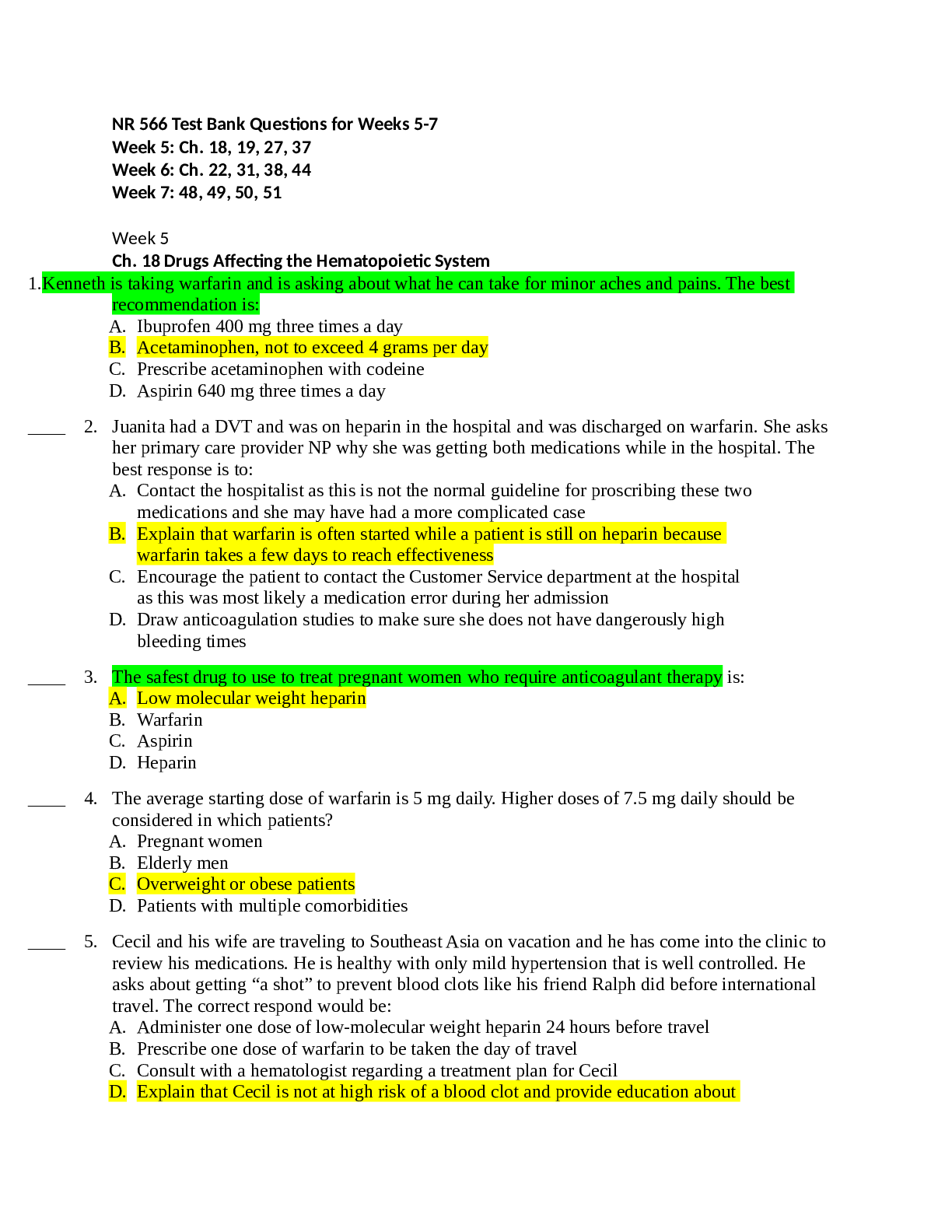*NURSING > EXAM > Test Bank Questions for Weeks 5 NR 566 Test Bank Questions for Weeks 5-7 (This year) (All)
Test Bank Questions for Weeks 5 NR 566 Test Bank Questions for Weeks 5-7 (This year)
Document Content and Description Below
Test Bank Questions for Weeks 5 NR 566 Test Bank Questions for Weeks 5 NR 566 Test Bank Questionsfor Weeks 5-7 Week 5: Ch. 18, 19, 27, 37 Week 6: Ch. 22, 31, 38, 44 Week 7: 48, 49, 50, 51 Week 5... Ch. 18 Drugs Affecting the Hematopoietic System 1.Kenneth is taking warfarin and is asking about what he can take for minor aches and pains. The best recommendation is: A. Ibuprofen 400 mg three times a day B. Acetaminophen, not to exceed 4 grams per day C. Prescribe acetaminophen with codeine D. Aspirin 640 mg three times a day 2. Juanita had a DVT and was on heparin in the hospital and was discharged on warfarin. She asks her primary care provider NP why she was getting both medications while in the hospital. The best response is to: A. Contact the hospitalist as this is not the normal guideline for proscribing these two medications and she may have had a more complicated case B. Explain that warfarin is often started while a patient is still on heparin because warfarin takes a few days to reach effectiveness C. Encourage the patient to contact the Customer Service department at the hospital as this was most likely a medication error during her admission D. Draw anticoagulation studies to make sure she does not have dangerously high bleeding times 3. The safest drug to use to treat pregnant women who require anticoagulant therapy is: A. Low molecular weight heparin B. Warfarin C. Aspirin D. Heparin 4. The average starting dose of warfarin is 5 mg daily. Higher doses of 7.5 mg daily should be considered in which patients? A. Pregnant women B. Elderly men C. Overweight or obese patients D. Patients with multiple comorbidities 5. Cecil and his wife are traveling to Southeast Asia on vacation and he has come into the clinic to Test Bank Questions for Weeks 5 review his medications. He is healthy with only mild hypertension that is well controlled. He asks about getting “a shot” to prevent blood clots like his friend Ralph did before international travel. The correct respond would be: A. Administer one dose of low-molecular weight heparin 24 hours before travel B. Prescribe one dose of warfarin to be taken the day of travel C. Consult with a hematologist regarding a treatment plan for Cecil D. Explain that Cecil is not at high risk of a blood clot and provide education about Test Bank Questions for Weeks 5 how to prevent blood clots while traveling 6. Robert, age 51 years, has been told by his primary care provider (PCP) to take an aspirin a day. Why would this be recommended? A. He has arthritis and this will help with the inflammation and pain. B. Aspirin has anti-platelet activity and prevents clots that cause heart attacks. C. Aspirin acidifies the urine and he needs this for prostrate health. D. He has a history of GI bleed, and one aspirin a day is a safe dose. 7. Sally has been prescribed aspirin 320 mg per day for her atrial fibrillation. She also takes aspirin four or more times a day for arthritis pain. What are the symptoms of aspirin toxicity she would need to be evaluated for: A. Tinnitus B. Diarrhea C. Hearing loss D. Photosensitivity 8. Patient education when prescribing clopidogrel includes: A. Do not take any herbal products without discussing with the provider B. Monitor urine output closely and contact the provider if it decreases C. Clopidogrel can be constipating, use a stool softener if needed D. The patient will need regular anticoagulant studies while on clopidogrel 9. For patients taking warfarin INRs are best drawn: A. Monthly throughout therapy B. Three times a week throughout therapy C. Two hours after the last dose of warfarin to get an accurate peak level D. In the morning if the patient takes their warfarin at night 10. Patients receiving heparin therapy require monitoring of: A. Platelets every 2 to 3 days for thrombocytopenia that may occur on Day 4 of therapy B. Electrolytes for elevated potassium levels in the first 24 hours of therapy C. INR throughout therapy to keep in the range around 2.0 D. Blood pressure for hypertension that may occur in the first 2 days of treatment 11. The routine monitoring recommended for low molecular weight heparin is: A. INR every 2 days until stable then weekly B. aPTT every week while on therapy C. Factor Xa levels if patient is pregnant D. White blood cell count every 2 weeks 12. When writing a prescription for warfarin it is common to write on the prescription. A. OK to substitute for generic B. The brand name of warfarin and Do Not Substitute C. PRN refills D. Refills for 1 year 13. Education of patients who are taking warfarin includes discussing their diet. Instructions include: Test Bank Questions for Weeks 5 A. Avoiding all vitamin K-containing foods B. Avoiding high vitamin K-containing foods C. Increasing intake of iron-containing foods D. Making sure they eat 35 grams of fiber daily 14. Patients who are being treated with epoetin alfa need to be monitored for the development of: A. Thrombocytopenia B. Neutropenia C. Hypertension D. Gout 15. The FDA issued a safety announcement regarding the use of erythropoiesis-stimulating agents (ESAs) in 2010 with the recommendation that: A. ESAs no longer be prescribed to patients with chronic renal failure B. The risk of tumor development be explained to cancer patients on ESA therapy C. Patients should no longer receive ESA therapy to prepare for allogenic transfusions D. ESAs be prescribed only to patients younger than age 60 years 16. When patients are started on darbepoetin alfa (Aranesp) they need monitoring of their blood counts to determine a dosage adjustment in: A. 6 weeks if they are a cancer patient B. 1 week if they have chronic renal failure C. 2 weeks if taking for allogenic transfusion D. Weekly throughout therapy 17. Jim is having a hip replacement surgery and would like to self-donate blood for the surgery. In addition to being prescribed epogen alpha he should also be prescribed: A. Folic acid to prevent megaloblastic anemia B. Iron, to start when the epogen starts C. An antihypertensive to counter the adverse effects of epogen D. Vitamin B12 to prevent pernicious anemia 18. Monitoring for a patient being prescribed iron for iron deficiency anemia includes: A. Reticulocyte count 1 week after therapy is started B. Complete blood count every 2 weeks throughout therapy C. Hemoglobin level at 1 week of therapy D. INR weekly throughout therapy 19. Patient education regarding taking iron replacements includes: A. Doubling the dose if they miss a dose to maintain therapeutic levels B. Taking the iron with milk or crackers if it upsets their stomach C. Iron is best taken on an empty stomach with juice D. Antacids such as Tums may help the upset stomach caused by iron therapy 20. Patients with pernicious anemia require treatment with: A. Iron B. Folic acid C. Epogen alpha D. Vitamin B12 Test Bank Questions for Weeks 5 21. The first lab value indication that Vitamin B12 therapy is adequately treating pernicious anemia is: A. Hematocrit levels start to rise B. Hemoglobin levels return to normal C. Reticulocyte count begins to rise D. Vitamin B12 levels return to normal 22. Patients who are beginning therapy with Vitamin B12 need to be monitored for: A. Hypertensive crisis that may occur in the first 36 hours B. Hypokalemia that occurs in the first 48 hours C. Leukopenia that occurs at 1 to 3 weeks of therapy D. Thrombocytopenia that may occur at any time in therapy 1. Week 5 Chapter 19: Drugs Affecting the Immune System Attenuated vaccines are also known as: A. Killed vaccines B. Booster vaccines C. Inactivated vaccines D. Live vaccines 2. Live attenuated influenza vaccine (FluMist) may be administered to: A. All patients over 6 months of age B. Patients between age 2 years and 49 years with no risk factors C. Patients with a URI or asthma D. Pregnant women 3. The reason that two MMR vaccines at least a month apart are recommended is: A. The second dose of MMR “boosts” the immunity built from the first dose B. Two vaccines 1 month apart is the standard dosing for all live virus vaccines C. If the two MMR vaccine doses are given too close together there is a greater likelihood of severe localized reaction to the vaccine D. Only 95% of patients are fully immunized for measles after the first vaccine, with 99% having immunity after two doses of MMR 4. MMR vaccine is not recommended for pregnant women because: A. Pregnant women do not build adequate immunity to the vaccine B. There is a risk of the pregnant women developing measles encephalopathy C. There is a risk of the fetus developing congenital rubella syndrome D. Pregnant women can receive the MMR vaccine 5. If the MMRV (measles, mumps, rubella, and varicella) combined vaccine is ordered to be given as the first MMR and varicella dose to a child the CDC recommends: A. Parents be informed of the increased risk of fever and febrile seizures over the MMR plus varicella 2 shot regimen B. Patients must also receive MMRV as the second dose of MMR and varicella in order to build adequate immunity C. Patients be premedicated with acetaminophen 15 minutes before the vaccine is given Test Bank Questions for Weeks 5 D. Patients should not be around pregnant women for the first 48 hours after the vaccine is given 6. The rotavirus vaccine (RotaTeq, Rotarix): A. Is a live vaccine that replicates in the small intestine, providing active immunity against rotavirus B. Should not be administered to infants who are or may be potentially immunocompromised C. Is not given to an infant who has a febrile illness (temperature greater than 100.5°F) D. All of the above 7. Varicella vaccine is recommended to be given to patients who are: A. HIV positive with a CD4+ T-lymphocyte percentage less than 15 percent B. Taking corticosteroids (up to 2 mg/kg/day or less than 20 mg/day) C. Pregnant D. Immunocompromised 8. Zoster vaccine (Zostavax) is: A. A live varicella zoster vaccine from the same strain used to develop the varicella vaccine B. Effective in preventing varicella zoster in patients of all ages C. Recommended for patients age 40 to 80 who have had chickenpox D. Administered at the same time as other live vaccines, as long as they are given the same day 9. True contraindications to diphtheria, tetanus, and acellular pertussis (DTaP or Tdap) vaccine include: A. Fever up to 104°F (40.5°C) after previous DTaP vaccine B. Family history of seizures after DTaP vaccine C. Adolescent pregnancy D. Anaphylactic reaction with a previous dose 10. Hepatitis B vaccine (HBV) is contraindicated in patients who: A. Were born less than 32 weeks gestation (give first dose at age 6 months) B. Are pregnant C. Are on hemodialysis D. Are allergic to yeast 11. Human papillomavirus (HPV) vaccine (Gardasil, Cervarix): A. Is a live virus vaccine that provides immunity to six strains of HPV virus B. Has a common adverse effect of syncope within 15 minutes of giving the vaccine C. Should not be given to males younger than age 12 years D. May be given to pregnant women 12. Influenza vaccine may be administered annually to: A. Patients with egg allergy B. Pregnant patients C. Patients age 6 weeks or older Test Bank Questions for Weeks 5 D. Patients with acute febrile illness 13. Immune globulin serums (IGs): A. Provide active immunity against infectious diseases B. Are contraindicated during pregnancy C. Are heated to above body temperature to kill most hepatitis, HIV, and other viruses such as parvovirus D. Are derived from pooled plasma of adults and contain specific antibodies in proportion to the donor population 14. Hepatitis B immune globulin (HBIG) is administered to provide passive immunity to: A. Infants born to HBsAg-positive mothers B. Household contacts of hepatitis-B virus infected people C. Persons exposed to blood containing hepatitis B virus D. All of the above 15. Rho(D) immune globulin (RhoGAM) is given to: A. Infants born to women who are Rh positive B. Sexual partners of Rh positive women C. Rh negative women after a birth, miscarriage, or abortion D. Rh negative women at 36 weeks gestation 16. Tuberculin purified protein derivative (PPD): A. Is administered to patients who are known tuberculin-positive reactors B. May be administered to patients who are on immunosuppressives C. May be administered 2 to 3 weeks after an MMR or varicella vaccine D. May be administered the same day as the MMR and/or varicella vaccine 17. Diane may benefit from cyclosporine (Sandimmune). Cyclosporin may be prescribed to: A. Treat rheumatoid arthritis B. Treat patients with corn allergy C. Pregnant patients D. Treat patients with liver dysfunction 18. Azathioprine has significant adverse drug effects, including: A. Hypertension B. Hirsutism C. Risk of cancer D. Gingival hyperplasia Week 5 Chapter 27 Anemia Pernicious anemia is treated with: A. Folic acid supplement B. Thiamine supplement C. Vitamin B12 D. Iron 2. Premature infants require iron supplementation with: A. 10 mg/day of iron Test Bank Questions for Weeks 5 B. 2 mg/kg per day until age 12 months C. 7 mg/day in diet D. 1 mg/kg per day until adequate intake of iron from foods 3. Breastfed infants should receive iron supplementation of: A. 3 mg/kg per day B. 6 mg/kg per day C. 1 mg/kg per day D. Breastfed babies do not need iron supplementation 4. Valerie presents to clinic with menorrhagia. Her hemoglobin is 10.2 and her ferritin is 15 ng/mL. Initial treatment for her anemia would be: A. 18 mg/day of iron supplementation B. 6 mg/kg per day of iron supplementation C. 325 mg ferrous sulfate per day D. 325 mg ferrous sulfate TID 5. Chee is a 15-month-old male whose screening hemoglobin is 10.4 g/dL. Treatment for his anemia would be: A. 18 mg/day of iron supplementation B. 6 mg/kg per day of elemental iron C. 325 mg ferrous sulfate per day D. 325 mg ferrous sulfate TID 6. Monitoring for a patient taking iron to treat iron deficiency anemia is: A. Hemoglobin, hematocrit, and ferritin 4 weeks after treatment is started B. Complete blood count every 4 weeks throughout treatment C. Annual complete blood count D. Reticulocyte count in 4 weeks 7. Valerie has been prescribed iron to treat her anemia. Education of patients prescribed iron would include: A. Take the iron with milk if it upsets her stomach B. Antacids may help with the nausea and GI upset caused by iron C. Increase fluids and fiber to treat constipation D. Iron is best tolerated if it is taken at the same time as her other medications 8. Allie has just had her pregnancy confirmed and is asking about how to ensure a healthy baby. What is the folic acid requirement during pregnancy? A. 40 mcg/day B. 400 mcg/day C. 800 mcg/day D. 2 gm/day 9. Kyle has Crohn’s disease and has a documented folate deficiency. Drug therapy for folate deficiency anemia is: A. Oral folic acid 1 to 2 mg per day B. Oral folic acid 1 gram per day C. IM folate weekly for at least 6 months Test Bank Questions for Weeks 5 D. Oral folic acid 400 mcg daily 10. Patients who are being treated for folate deficiency require monitoring of: A. Complete blood count every 4 weeks B. Hematocrit and hemoglobin at 1 week and then at 8 weeks C. Reticulocyte count at 1 week D. Folate levels every 4 weeks until hemoglobin stabilizes 11. The treatment of vitamin B12 deficiency is: A. 1,000 mcg daily of oral cobalamin B. 2 gm per day of oral cobalamin C. 100 mcg/day Vitamin B12 IM D. 500 mcg/dose nasal cyanocobalamin 2 sprays once a week 12. The dosage of Vitamin B12 to initially treat pernicious anemia is: A. Nasal cyanocobalamin 1 gram spray in each nostril daily x 1 week then weekly x 1 month B. Vitamin B12 IM monthly C. Vitamin B12 1,000 mcg IM daily x 1 week then 1,000 mg weekly for a month D. Oral cobalamin 1,000 mcg daily 13. Before beginning IM Vitamin B12 therapy, which laboratory values should be obtained? A. Reticulocyte count, hemoglobin, and hematocrit B. Iron C. Vitamin B12 D. All of the above 14. should be monitored when Vitamin B12 therapy is started. A. Serum calcium B. Serum potassium C. Ferritin D. C-reactive protein 15. Anemia due to chronic renal failure is treated with: A. Epoetin alfa (Epogen) B. Ferrous sulfate C. Vitamin B12 D. Hydroxyurea Week 5 Chapter 37: HIV The goals of treatment when prescribing antiretroviral medication to patients with HIV include: A. Prevent vertical HIV transmission B. Improve quality of life C. Prolong survival D. All of the above 2. A challenge faced with antiretroviral therapy (ART) is: A. Patients abusing ART B. Drug-resistant mutations of HIV Test Bank Questions for Weeks 5 C. Reduction of transmissibility of HIV D. Lack of efficacy data 3. Predictors for successful treatment with antiretroviral therapy (ART) in HIV-positive patients include: A. They respond to low potency treatment regimen B. They have demonstrated resistance in the past and should respond to newer ART drugs C. The patient is strictly adherent to the ART treatment regimen D. Lower baseline CD4 T-cell count at baseline 4. The goal of antiretroviral therapy (ART) in HIV-positive patients is: A. Maximum suppression of HIV replication B. Eradication of HIV virus from the body C. Determining a treatment regimen that is free of adverse effects D. Suppression of CD4 T-cell count 5. Pregnant women who are HIV positive: A. Are treated with AZT alone to prevent birth defects B. Are treated with a combination ART regimen C. Should not be treated with ART due to teratogenicity of the drugs D. Are at high risk of developing resistance to ART drugs 6. Antiretroviral therapy is recommended for HIV-positive patients with: A. A history of AIDS-defining illness B. Pregnant women C. Hepatitis B co-infection D. All of the above 7. If considering starting a patient on the nucleoside reverse transcriptase inhibitor (NRTI) abacavir, the following testing is recommended prior to prescribing: A. Renal function B. HLA B*5701 testing C. Pancreatic enzyme levels D. CYP 450 enzyme activity 8. Suzanne is pregnant and has tested HIV positive. Which antiretroviral drug should be avoided in women who are pregnant? A. Lopinavir/r B. Zidovudine C. Ritonavir D. Lopinavir/ritonavir 9. The cost of HIV treatment can be prohibitive for any patient. Patients can receive assistance from the: A. Best Pharmaceuticals for HIV/AIDS Patient Act B. Ryan White HIV/AIDS Treatment Modernization Act C. National Institute of Health HIV/AIDS Assistance Fund D. Centers for Disease Control HIV/AIDS Treatment Fund Test Bank Questions for Weeks 5 10. Resistance to antiretroviral therapy (ART) is measured by: A. Measuring the DNA viral load in the serum B. Determining plasma viral RNA on two successive measurements C. Phenotype assays of the combination of ART the patient is on D. Elevation of T4 counts 11. Phenotype assays are used to measure of antiretroviral therapy (ART). A. Effectiveness B. Genotype C. Sensitivity D. Hypersensitivity susceptibility 12. Patient factors that contribute to antiretroviral therapy (ART) failure include: A. Being a male who has sex with males B. HIV diagnosis in pregnancy C. Good compliance with ART treatment regimen D. ART adverse effects 13. Patients who are taking antiretroviral therapy (ART) need to have the following monitored: A. Lipid levels B. Sexual functioning C. Platelet count D. All of the above 14. Successful antiretroviral therapy (ART) in an HIV-positive patient is determined by: A. Being able to stop ART therapy due to HIV virus eradication B. Lowering HIV viral load to unmeasurable amounts C. Individual measures of success based on their personal situation D. Normal blood hematologic factors Week 6 Chapter 22 Drugs affecting the reproductive system Men who use transdermal testosterone gel (AndroGel) should be advised to avoid: A. Washing their hands after applying the gel B. Wearing occlusive clothing while using the gel C. Exposure to estrogens while using the gel D. Skin-to-skin contact with pregnant women while using the gel 2. Education when prescribing androgens to male patients includes: A. Short-term use places the patient at risk for hepatocellular carcinoma B. Cholestatic hepatitis and jaundice may occur with low doses of androgens C. Gynecomastia is a rare occurrence with the use of androgens D. Low sperm levels only occur with long-term use of androgens 3. Patients who are prescribed exogenous androgens need to be warned that decreased libido: A. Is an unusual side effect of androgens and should be reported to the provider B. Is treated with increased doses of androgens, so the patient should let the provider know if he is having problems C. May be a sign of early prostate cancer and he should make an appointment for a Test Bank Questions for Weeks 5 prostate screening exam D. May occur with androgen therapy 4. The U.S. Food and Drug Administration (FDA) warns that androgens may cause: A. Peliosis hepatis B. Orthostatic hypotension C. Menstrual irregularities D. Acne 5. Monitoring for a patient who is using androgens includes: A. Complete blood count and C-reactive protein level B. Lipid levels and liver function tests C. Serum potassium and magnesium levels D. Urine protein and potassium levels 6. Male patients require before and during androgen therapy. A. A digital prostate exam B. A Doppler exam of testicular blood flow C. Urine analysis for proteinuria D. Serial orthostatic blood pressures 7. Absolute contraindications to estrogen therapy include: A. History of any type of cancer B. Clotting disorders C. History of tension headache D. Orthostatic hypotension 8. Women with an intact uterus should not be prescribed: A. Estrogen/progesterone combination B. IM medroxyprogesterone (Depo Provera) C. Estrogen alone D. Androgens 9. Women who have migraine with aura should not be prescribed estrogen due to: A. The interaction between triptans and estrogen, limiting migraine therapy choices B. An increased incidence of migraines with the use of estrogen C. An increased risk of stroke occurring with estrogen use D. Patients with migraines may be prescribed estrogen without any concerns 10. A 22-year-old women receives a prescription for oral contraceptives. Education for this patient includes: A. Counseling regarding decreasing or not smoking while taking oral contraceptives B. Advising a monthly pregnancy test for the first 3 months she is taking the contraceptive C. She may miss two pills in a row and not be concerned about pregnancy D. Her next follow-up visit is in 1 year for a refill and “annual exam” Test Bank Questions for Weeks 5 11. A 19-year-old female is a nasal Staph aureus carrier and is placed on 5 days of rifampin for treatment. Her only other medication is combined oral contraceptives. What education should she receive regarding her medications? A. Separate the oral ingestion of the rifampin and oral contraceptive by at least an hour. B. Both medications are best tolerated if taken on an empty stomach. C. She should use a back-up method of birth control such as condoms for the rest of the current pill pack. D. If she gets nauseated with the medications she should call the office for an antiemetic prescription. 12. A 56-year-old women is complaining of vaginal dryness and dyspareunia. To treat her symptoms with the lowest adverse effects she should be prescribed: A. Low-dose oral estrogen B. Low-dose estrogen/progesterone combination C. Vaginal estradiol ring D. Vaginal progesterone cream 13. Shana is receiving her first medroxyprogesterone (Depo Provera) injection. Shana will need to be monitored for: A. Depression B. Hypertension C. Weight loss D. Cataracts 14. When prescribing medroxyprogesterone (Depo Provera) injections, essential education would include the adverse drug effects of: A. Hypertension and dysuria B. Depression and weight gain C. Abdominal pain and constipation D. Orthostatic hypotension and dermatitis 15. Medroxyprogesterone (Depo Provera) injection has an FDA Black Box warning due to: A. Development of significant hypertension B. Increased risk of strokes when on Depo C. Decreased bone density while on Depo D. Risk of life-threatening rash such as Stevens-Johnson 16. Shana received her first medroxyprogesterone (Depo Provera) injection 6 weeks ago and calls the clinic with a concern that she has been having a light “period” off and on since receiving her Depo shot. What would be the management of Shana? A. Reassurance that some spotting is normal the first few months of Depo and it should improve. B. Schedule an appointment for an exam as this is not normal. C. Prescribe 4 weeks of estrogen to treat the abnormal vaginal bleeding. D. Order a pregnancy test and suggest she use a back-up method of contraception until she has her next shot. Test Bank Questions for Weeks 5 17. William is a 62-year-old male who is requesting a prescription for sildenafil (Viagra). He should be screened for before prescribing sildenafil. A. Renal dysfunction B. Unstable coronary artery disease C. Benign prostatic hypertrophy D. History of priapism 18. Men who are prescribed sildenafil (Viagra) need ongoing monitoring for: A. Development of chest pain or dizziness B. Weight gain C. Priapism D. Renal function 19. Men who are prescribed an erectile dysfunction drug such as sildenafil (Viagra) should be warned about the risk for: A. Impotence when combined with antihypertensives B. Fatal hypotension if combined with nitrates C. Weight gain if combined with antidepressants D. All of the above Week 6 Chapter 31 Contraception Women who are taking an oral contraceptive containing the progesterone drospirenone may require monitoring of: A. Hemoglobin B. Serum calcium C. White blood count D. Serum potassium 2. The mechanism of action of oral combined contraceptives which prevents pregnancy is: A. Estrogen prevents the LH surge necessary for ovulation B. Progestins thicken cervical mucous and slow tubal motility C. Estrogen thins the endometrium making implantation difficult D. Progestin suppresses FSH release 3. To improve actual effectiveness of oral contraceptives women should be educated regarding: A. Use of a back-up method if they have vomiting or diarrhea during a pill packet B. Doubling pills if they have diarrhea during the middle of a pill pack C. They will have a normal menstrual cycle if they miss two pills D. Mid-cycle spotting is not normal and the provider should be contacted immediately 4. A contraindication to the use of combined contraceptives is: A. Adolescence (not approved for this age) B. A history of clotting disorder C. Recent pregnancy D. Overweight 5. Obese women may have increased risk of failure with which contraceptive method? A. Combined oral contraceptives Test Bank Questions for Weeks 5 B. Progestin-only oral contraceptive pill C. Injectable progestin D. Combined topical patch 6. Ashley comes to clinic with a request for oral contraceptives. She has successfully used oral contraceptives before and has recently started dating a new boyfriend so would like to restart contraception. She denies recent intercourse and has a negative urine pregnancy test in the clinic. An appropriate plan of care would be: A. Recommend she return to the clinic at the start of her next menses to get a Depo Provera shot B. Prescribe oral combined contraceptives and recommend she start them at the beginning of her next period and use a back-up method for the first 7 days C. Prescribe oral contraceptives and have her start them the same day with a back-up method used for the first 7 days D. Discuss the advantages of using the topical birth control patch and recommend she consider using the patch 7. When discussing with a patient the different start methods used for oral combined contraceptives, the advantage of a Sunday start over the other start methods is: A. Immediate protection against pregnancy the first week of using the pill B. No back-up method is needed when starting C. Menses occur during the week D. They can start the pill on the Sunday after the office visit 8. The topical patch combined contraceptive (Ortho Evra) is: A. Started on the first day of the menstrual cycle B. Recommended for women over 200 pounds C. Is not as effective as oral combined contraceptives D. Has more adverse effects, such as nausea, than the oral combined contraceptives 9. Progesterone-only pills are recommended for women who: A. Are breastfeeding B. Have a history of migraine C. Have a medical history that contradicts the use of estrogen D. All of the above 10. Women who are prescribed progestin-only contraception need education regarding which common adverse drug effects? A. Increased migraine headaches B. Increased risk of developing blood clots C. Irregular vaginal bleeding for the first few months D. Increased risk for hypercalcemia 11. An advantage of using the NuvaRing vaginal ring for contraception is: A. It does not require fitting and is easy to insert B. It is inserted once a week, eliminating the need to remember to take a daily pill C. Patients get a level of estrogen and progestin equal to combined oral contraceptives D. All of the above Test Bank Questions for Weeks 5 12. Oral emergency contraception (Plan B) is contraindicated in women who: A. Had intercourse within the past 72 hours B. May be pregnant C. Are taking combined oral contraceptives D. Are using a diaphragm Week 6 Chapter 38: Hormone Replacement Therapy and Osteoporosis The goals of therapy when prescribing hormone replacement therapy (HRT) include reducing: A. Cardiovascular risk B. Risk of stroke or other thromboembolic event C. Breast cancer D. Vasomotorsymptoms 2. The optimal maximum time frame for hormone replacement therapy (HRT) or estrogen replacement therapy (ERT) is: A. 2 years B. 5 years C. 10 years D. 15 years 3. Dosage changes of conjugated equine estrogen (Premarin) are made at intervals. A. 1 to 2 week B. 2 to 4 week C. 6 to 8 week D. 12 week 4. The advantage of vaginal estrogen preparations in the treatment of vulvovaginal atrophy and dryness is: A. Ability to deliver higher doses of estrogen in a non-oral form B. The vaginal cream formula provides moisture to the vaginal area C. Relief of symptoms without increasing cardiovascular risk D. All of the above 5. Women with an intact uterus should be treated with both estrogen and progestin due to: A. Increased risk for endometrial cancer if estrogen alone is used B. Combination therapy provides the best relief of menopausal vasomotor symptoms C. Reduced risk for colon cancer with combined therapy D. Lower risk of developing blood clots with combined therapy 6. Ongoing monitoring for women on estrogen replacement therapy (ERT) includes: A. Lipid levels, repeated annually if abnormal B. Annual health history and review of risk profile C. Annual mammogram D. All of the above 7. Kristine would like to start hormone replacement therapy (HRT) to treat the significant vasomotor symptoms she is experiencing during menopause. Education for a woman considering hormone replacement would include: Test Bank Questions for Weeks 5 A. Explaining that HRT is totally safe if used short term B. Telling her to ignore media hype regarding HRT C. Discussing the advantages and risks of HRT D. Encouraging the patient to use phytoestrogens with the HRT 8. Angela is a black woman who has heard that women of African descent do not need to worry about osteoporosis. What education would you provide Angela about her risk? A. She is correct, black women do not have much risk of developing osteoporosis due to their dark skin B. Black women are at risk of developing osteoporosis due to their lower calcium intake as a group C. If she doesn’t drink alcohol, her risk of developing osteoporosis is low D. If she has not lost more than 10% of her weight lately, her risk is low 9. Drugs that increase the risk of osteoporosis developing include: A. Oral combined contraceptives B. Carbamazepine C. Calcium channel blockers D. High doses of Vitamin D 10. Selective estrogen receptor modifiers (SERMs) treat osteoporosis by selectively: A. Inhibiting magnesium resorption in the kidneys B. Increasing calcium absorption from the GI tract C. Acting on the bone to inhibit osteoblast activity D. Selectively acting on the estrogen receptors in the bone 11. Sallie has been diagnosed with osteoporosis and is asking about the “once a month” pill to treat her condition. How do bisphosphonates treat osteoporosis? A. By selectively activating estrogen pathways in the bone B. By reducing bone resorption by inhibiting PTH C. By reducing bone resorption and inhibiting osteoclastic activity D. By increasing parathyroid hormone production 12. Inadequate Vitamin D intake can contribute to the development of osteoporosis by: A. Increasing calcitonin production B. Increasing calcium absorption from the intestine C. Altering calcium metabolism D. Stimulating bone formation 13. Cassie is a 15-year-old female who presents to clinic for a sports physical. Her diet history indicates she drinks less than one glass of milk per day and avoids dairy products to lose weight. What is the recommended daily calcium intake for Cassie? A. 500 mg B. 1,000 mg C. 1,300 mg D. 1,500 mg 14. Susan is a 52-year-old perimenopausal woman who is lactose intolerant. What is her recommended calcium and vitamin D requirement? Test Bank Questions for Weeks 5 A. 1,500 mg calcium and 200 IU Vitamin D B. 1,200 mg calcium and 400 IU Vitamin D C. 1,300 mg calcium and 400 IU Vitamin D D. 1,000 mg calcium and 400 IU Vitamin D 15. The drug recommended as primary prevention of osteoporosis in women over age 70 years is: A. Alendronate (Fosamax) B. Ibandronate (Boniva) C. Calcium carbonate D. Raloxifene (Evista) 16. The drug recommended as primary prevention of osteoporosis in men over age 70 years is: A. Alendronate (Fosamax) B. Ibandronate (Boniva) C. Calcium carbonate D. Raloxifene (Evista) 17. Intranasal calcitonin is used in the treatment of osteoporosis. Calcitonin therapy is appropriate for which patient? A. Thin, Caucasian perimenopausal women B. Men over age 65 with osteoporosis C. Women over age 65 years with osteopenia D. Women over age 65 with severe osteoporosis 18. The ongoing monitoring for patients over age 65 years taking alendronate (Fosamax) or any other bisphosphonate is: A. Annual DEXA scans B. Annual Vitamin D level C. Annual renal function evaluation D. Electrolytes every 3 months Week 6 Chapter 44: STI and Vaginitis The goals of treatment when prescribing for sexually transmitted infections include: A. Treatment of infection B. Prevention of disease spread C. Prevention of long-term sequelae from the infection D. All of the above 2. The drug of choice for treatment of primary or secondary syphilis is: A. Ceftriaxone IM B. Benzathine penicillin G IM C. Oral azithromycin D. Oral ciprofloxacin 3. The drug of choice for treatment of early latent or tertiary syphilis is: A. Ceftriaxone IM B. Benzathine penicillin G IM C. Oral azithromycin Test Bank Questions for Weeks 5 D. Oral ciprofloxacin 4. Demione is a 24 year old who is 32 weeks pregnant and has tested positive for syphilis. The best treatment for her would be: A. IM ceftriaxone B. IM benzathine penicillin G C. Oral azithromycin D. Any of the above 5. Treatment for suspected gonorrhea is: A. Ceftriaxone 250 mg IM x 1 B. Ceftriaxone 2 grams IM x 1 C. Ciprofloxacin 500 mg PO x 1 D. Doxycycline 100 mg BID x 7 days 6. When treating suspected gonorrhea in a non-pregnant patient, the patient should be concurrently treated for Chlamydia with: A. Azithromycin 1 gram PO x 1 B. Amoxicillin 500 mg PO x 1 C. Ciprofloxacin 500 mg PO x 1 D. Penicillin G 2.4 million units IM x 1 7. Ongoing monitoring is essential after treating for gonorrhea. The patient should be rescreened for gonorrhea and Chlamydia in: A. 4 weeks B. 3 to 6 weeks C. 3 to 6 months D. 1 year 8. A test of cure is recommended after treating Chlamydia in which patient population? A. Men who have sex with men B. Adolescent females C. Pregnant patients D. All of the above 9. Treatment for chancroid in a non-pregnant patient would be: A. Oral azithromycin B. IM ceftriaxone C. Oral ciprofloxacin D. Any of the above 10. Jamie was treated for chancroid. Follow-up testing after treatment of chancroid would be: A. Syphilis and HIV testing at 3-month intervals B. Chancroid-specific antigen test every 3 months C. Urine testing for Haemophilus ducreyi in 3 to 6 months for test of cure D. Annual HIV testing if engaging in high-risk sexual behavior Test Bank Questions for Weeks 5 11. Helima presents with a complaint of vaginal discharge that when tested meets the criteria for bacterial vaginosis. Treatment of bacterial vaginosis in a non-pregnant symptomatic women would be: A. Metronidazole 500 mg PO BID x 7 days B. Doxycycline 100 mg PO BID x 7 days C. Intravaginal tinidazole daily x 5 days D. Metronidazole 2 grams PO x 1 dose 12. Besides prescribing antimicrobial therapy, patients with bacterial vaginosis require education regarding: A. The most recent partners in the past 60 days should also be treated B. Alcohol should not be consumed during and for 1 day after metronidazole is taken C. Condoms should be used during intercourse if intravaginal clindamycin cream is used D. Necessity of co-treatment for Chlamydia 13. Sydney presents to clinic with vulvovaginal candidiasis. Appropriate treatment for her would be: A. OTC intravaginal clotrimazole B. OTC intravaginal miconazole C. Oral fluconazole one-time dose D. Any of the above 14. If a woman presents with recurrent vulvovaginal candidiasis she may be treated with: A. Weekly intravaginal butoconazole for 3 months B. Fluconazole 150 mg PO daily x 7 doses then monthly for 6 months C. Weekly fluconazole 150 mg PO x 6 months D. Intravaginal tioconazole x 14 days 15. Zoe presents with genital warts present on her labia. Patient-applied topical therapy for warts includes: A. Podofilox 0.5% gel B. Podophyllin 10% resin C. Trichloracetic acid D. Any of the above 16. Sophie presents to clinic with a malodorous vaginal discharge and is confirmed to have Trichomonas infection. Treatment for her would include: A. Metronidazole 2 grams PO x 1 dose B. Topical intravaginal metronidazole daily x 7 days C. Intravaginal clindamycin daily x 7 days D. Azithromycin 2 grams PO x 1 dose 17. In addition to antimicrobial therapy, patients treated for Trichomonas infection should be educated regarding: A. Necessity of treating sexual partner simultaneously B. Abstaining from intercourse until both partners are treated C. Need for retesting in 3 months due to high reinfection rate D. All of the above Test Bank Questions for Weeks 5 Week7 Ch. 48 Women as Patients Prescribing for women during their childbearing years requires constant awareness of the possibility of: A. Pregnancy unless the women is on birth control B. Risk for silent bacterial or viral infections of the genitalia C. High risk for developmental disorders in their infants D. Decreased risk for abuse during this time 2. 3. 4. 5. 6. 7. Intimate partner violence is a serious public health problem. It should be screened for: A. At every encounter with the health care system B. When a women is being seen for symptoms of depression C. Throughout pregnancy D. If a sexually transmitted disease is diagnosed Because of their longer life expectancy, women are more likely than men to experience a disabling condition. Common conditions in older women that can produce disability include: A. Depression B. Panic disorders C. Dementia D. All of the above Gender differences between men and women in pharmacokinetics include: A. More rapid gastric emptying so that drugs absorbed in the stomach have less exposure to absorption sites B. Higher proportion of body fat so that lipophilic drugs have relatively greater volumes of distribution C. Increased levels of bile acids so that drugs metabolized in the intestine have higher concentrations D. Slower organ blood flow rates to that drugs tend to take longer to be excreted Which of the following drug classes is associated with significant differences in metabolism based on gender? A. Beta blockers B. Antibiotics C. Serotonin reuptake inhibitors D. ACE inhibitors Since 40% of bone accrual occurs during adolescence, building bone during this time is critical. Ways to improve bone accrual in adolescents include: A. Use of bisphosphonates early if DEXA scans show limited bone accrual B. Encouraging a daily dietary intake of 1300 mg of calcium and 400 IU of vitamin D C. Avoiding all birth control methods that include progesterone D. Fostering the intake of iron mainly in green and leafy vegetables The physiologic anemia of pregnancy can be treated with: A. Drinking to cups per day of stinging nettle tea with cinnamon and honey B. Taking ferrous sulfate tablets with citrus juices C. Both A and B D. Neither A nor B Test Bank Questions for Weeks 5 8. 9. Hot flashes are often a concern during menopause. Which of the following may help in reducing them? A. Drink one caffeinated liquid per day B. Take progesterone supplementation C. Exercise 20 to 40 minutes/day D. Increase intake of carrots, yams, and soy products Factors common in women that can affect adherence to a treatment regimen include all of the following EXCEPT: A. Number of drug taken: Women tend to take less drugs but over longer periods of time B. Fear that medications can cause disease: Information obtained from social networks may be inaccurate for a specific woman C. Nutritional status: Worries about possible weight gain from a given drug may result in non-adherence D. Religious differences: A patient’s belief system that is not congruent with the treatment regimen presents high risk for nonadherence. 10. Dysmenorrhea is one of the most common gynecological complaints in young women. The first line of drug treatment for this disorder is: A. Oral contraceptive pills B. Caffeine C. NSAIDs D. Aspirin 11. Premenstrual dysphoric disorder (PMDD) occurs in a fairly small number of patients. Theories of the pathology behind PMDD that are supported in research include: A. Altered sensitivity in the serontonic system B. Inhibition of the cyclooxygenase system C. Fluctuations of the gonadal hormones D. All of these are theories supported by research 12. Treatment of PMDD that affects all or most of the symptoms includes: A. Tryptophan up to 6 g/d B. Vitamin E 200 to 400 mg/d C. Evening primrose oil 500 mg/d D. Fluoxetine 20 mg/d 13. Women are now the fastest growing population with HIV infection and AIDS. HIV infected women: A. Are less likely to become pregnant or to carry a pregnancy to term B. Have higher rates of cervical dysplasia and HPV concurrent infections C. Are most often over 35 years of age D. Most often come from Asian and Caucasian ethnic groups 14. Maternal-to-child transmission of HIV infection during pregnancy may be prevented by: A. Use of antiviral drugs such as zidovudine B. Use of condoms during intercourse Test Bank Questions for Weeks 5 C. Both A and B D. Neither A nor B 15. Erroneous information about LGBTQ individuals can lead to failure to give accurate advice to them as patients. Which of the following statements are true about lesbians: A. Lesbians cannot contract a sexually transmitted infection form their female partner B. Screening for cervical cancer is not required C. Lesbians as a group are less likely to have health care insurance D. Like women in general, lesbians are more likely than gay men to seek care for health related issues Week 7 Chapter 49 Men as Patients The factor that has the greatest effect on males developing male sexual characteristics is: A. Cultural beliefs B. Effective male role models C. Adequate intake of testosterone in the diet D. Androgen production 2. When assessing a male for hypogonadism prior to prescribing testosterone replacement, serum testosterone levels are drawn: A. Without regard to time of day B. First thing in the morning C. Late afternoon D. In the evening 3. Some research supports that testosterone replacement therapy may be indicated in which of the following diagnoses in men? A. Age-related decrease in cognitive functioning B. Metabolic syndrome C. Decreased muscle mass in aging men D. All of the above 4. The goal of testosterone replacement therapy is: A. Absence of all hypogonadism symptoms B. Testosterone levels in the mid-normal range 1 week after an injection C. Testosterone levels in the mid-normal range just prior to the next injection D. Avoidance of high serum testosterone levels during therapy 5. While on testosterone replacement, hemoglobin and hematocrit levels should be monitored. Levels suggestive of excessive erythrocytosis or abuse are: A. Hemoglobin 14 g/dl or hematocrit 39% B. Hemoglobin 11.5 g/dl or hematocrit 31% C. Hemoglobin 13 g/dl or hematocrit 38% D. Hemoglobin 17.5 g/dl or hematocrit 54% 6. Monitoring of an older male patient on testosterone replacement includes: A. Oxygen saturation levels at every visit B. Serum cholesterol and lipid profile every 3 to 6 months Test Bank Questions for Weeks 5 C. Digital rectal prostate screening exam at 3 and 6 months after starting therapy D. Bone mineral density at 3 months and 6 months after starting therapy 7. When prescribing phosphodiesterase type 5 (PDE-5) inhibitors such as sildenafil (Viagra) patients should be screened for use of: A. Statins B. Nitrates C. Insulin D. Opioids 8. Men who are prescribed phosphodiesterase type 5 (PDE-5) inhibitors for erectile dysfunction should be educated regarding the adverse effects of the drug which include: A. Hearing loss B. Hypotension C. Delayed ejaculation D. Dizziness 9. Male patients who should not be prescribed phosphodiesterase type 5 (PDE-5) inhibitors include: A. Diabetics B. Those who have had an acute myocardial infarction in the past 6 months C. Patients who are deaf D. Patients under age 60 years of age 10. Monitoring of male patients who are using phosphodiesterase type 5 (PDE-5) inhibitors includes: A. Serum fasting glucose levels B. Cholesterol and lipid levels C. Blood pressure D. Complete blood count Week 7 Chapter 50: Pediatric Patients The Pediatric Research Equity Acts requires: A. All children be provided equal access to drug research trials B. Children to be included in the planning phase of new drug development C. That pediatric drug trials guarantee children of multiple ethnic groups are included D. All applications for new active ingredients, new indications, new dosage forms, or new routes of administration require pediatric studies 2. The Best Pharmaceuticals for Children Act: A. Includes a pediatric exclusivity rule which extends the patent on drugs studied in children B. Establishes a committee that writes guidelines for pediatric prescribing C. Provides funding for new drug development aimed at children D. Encourages manufacturers specifically to develop pediatric formulations 3. The developmental variation in Phase I enzymes has what impact on pediatric prescribing? A. None, Phase I enzymes are stable throughout childhood. B. Children should always be prescribed lower than adult doses per weight due to low enzyme activity until puberty. Test Bank Questions for Weeks 5 C. Children should always be prescribed higher than adult doses per weight due to high enzyme activity. D. Prescribing dosages will vary based on the developmental activity of each enzyme, at times requiring lower than adult doses and other times higher than adult doses based on the age of the child. 4. Developmental variation in renal function has what impact on prescribing for infants and children? A. Lower doses of renally excreted drugs may be prescribed to infants younger than age 6 months. B. Higher doses of water soluble drugs may need to be prescribed due to increased renal excretion. C. Renal excretion rates have no impact on prescribing. D. Parents need to be instructed on whether drugs are renally excreted or not. 5. Topical corticosteroids are prescribed cautiously in young children due to: A. They may cause an intense hypersensitivity reaction B. Hypothalamic-pituitary-adrenal (HPA) axis suppression C. Corticosteroids are less effective in young children D. Young children may accumulate corticosteroids leading to toxic levels 6. Liza is breastfeeding her 2-month-old son and has an infection that requires an antibiotic. What drug factors influence the effect of the drug on the infant? A. Maternal drug levels B. Half-life C. Lipid-solubility D. All of the above 7. Drugs that are absolutely contraindicated in lactating women include: A. Selective serotonin reuptake inhibitors B. Antiepileptic drugs such as carbamazepine C. Antineoplastic drugs such as methotrexate D. All of the above 8. Zia is a 4 month old with otitis media. Education of his parents regarding administering oral antibiotics to an infant includes: A. How to administer an oral drug using a medication syringe B. Mixing the medication with a couple ounces of formula and putting it in a bottle C. Discontinuing the antibiotic if diarrhea occurs D. Calling for an antibiotic change if the infant chokes and sputters during administration 9. To increase adherence in pediatric patients a prescription medication should: A. Have a short half-life B. Be the best tasting of the effective drugs C. Be the least concentrated form of the medication D. Be administered 3 or 4 times a day 10. Janie is a 5-month-old breastfed infant with a fever. Treatment for her fever may include: Test Bank Questions for Weeks 5 A. “Baby” aspirin B. Acetaminophen suppository C. Ibuprofen suppository D. Alternating acetaminophen and ibuprofen Treatment for pmdd Fluoxetine (Prozac), Citalopram (Celexa), Sertraline (Zoloft), Paroxetine (Paxil) Folate deficiency, you need to monitor H&H Taking Plavix tell doctor you’re taking herbal supplements [Show More]
Last updated: 1 year ago
Preview 1 out of 26 pages
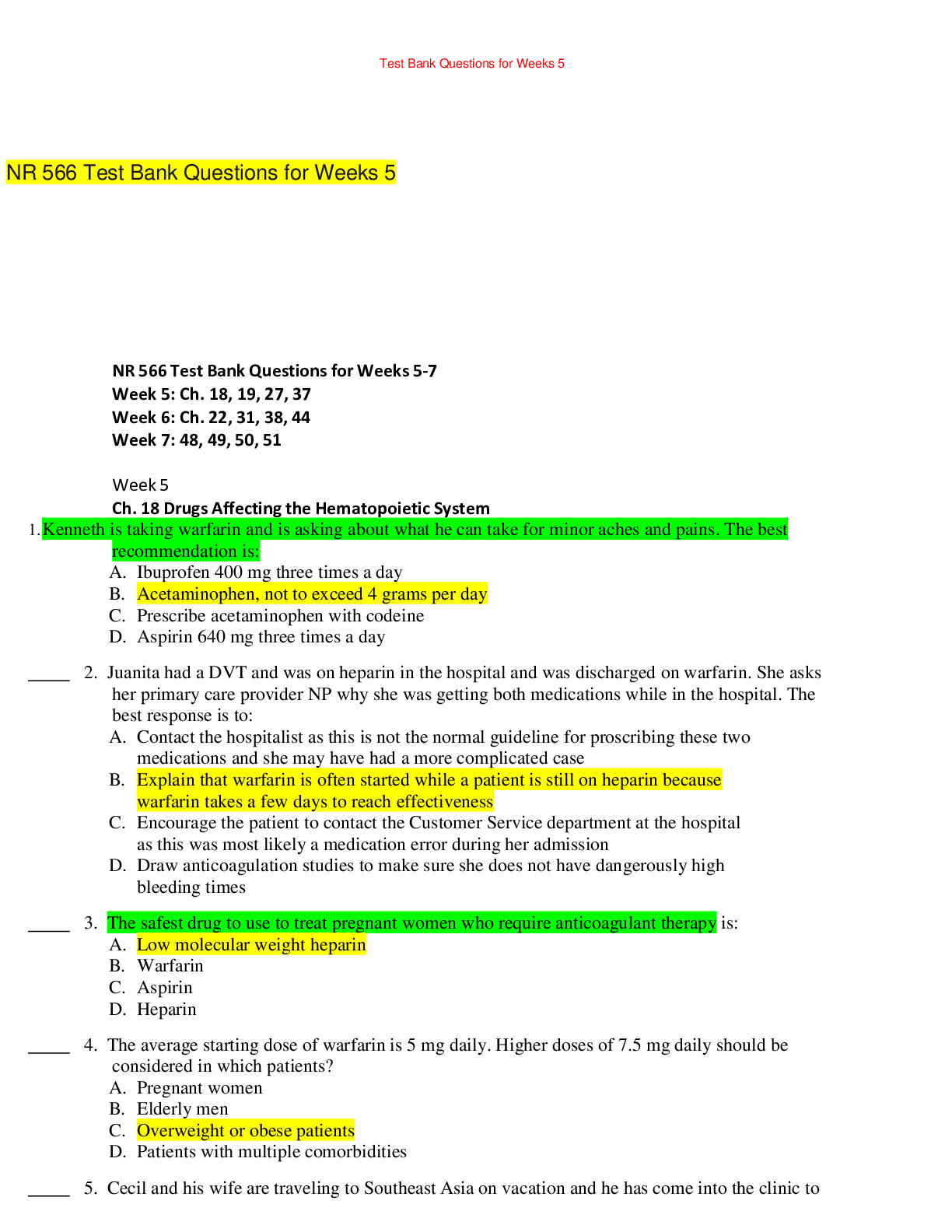
Reviews( 0 )
Document information
Connected school, study & course
About the document
Uploaded On
Feb 08, 2023
Number of pages
26
Written in
Additional information
This document has been written for:
Uploaded
Feb 08, 2023
Downloads
0
Views
37




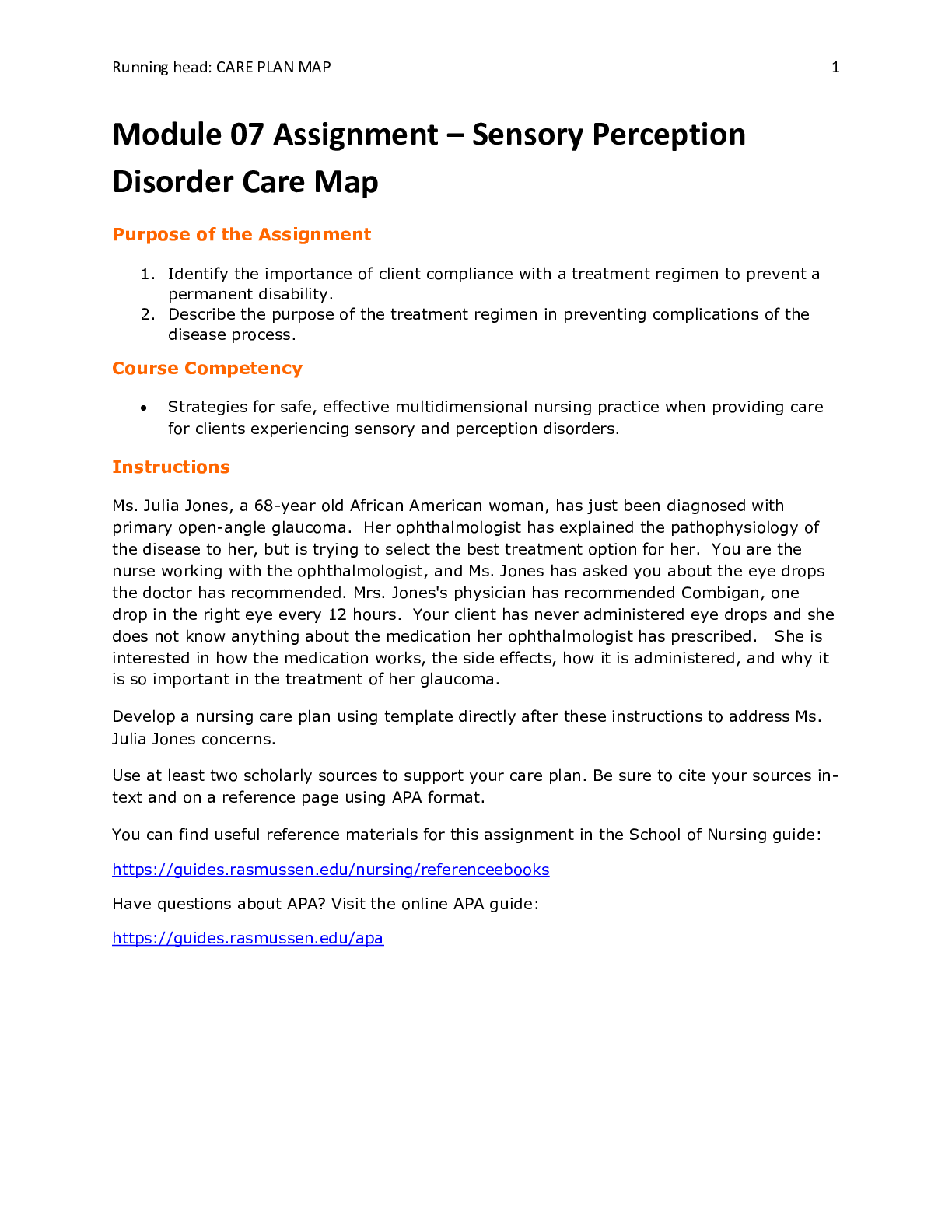
.png)


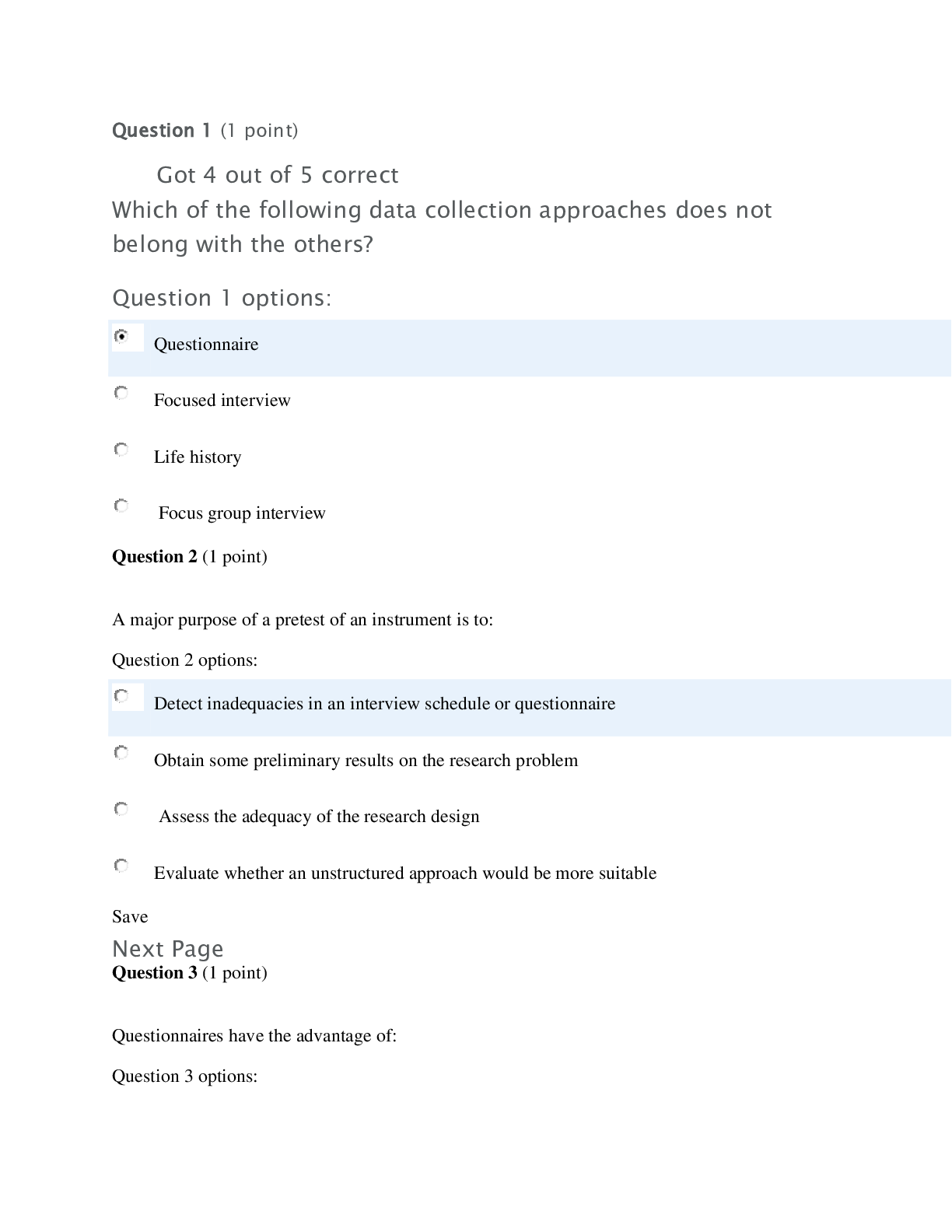


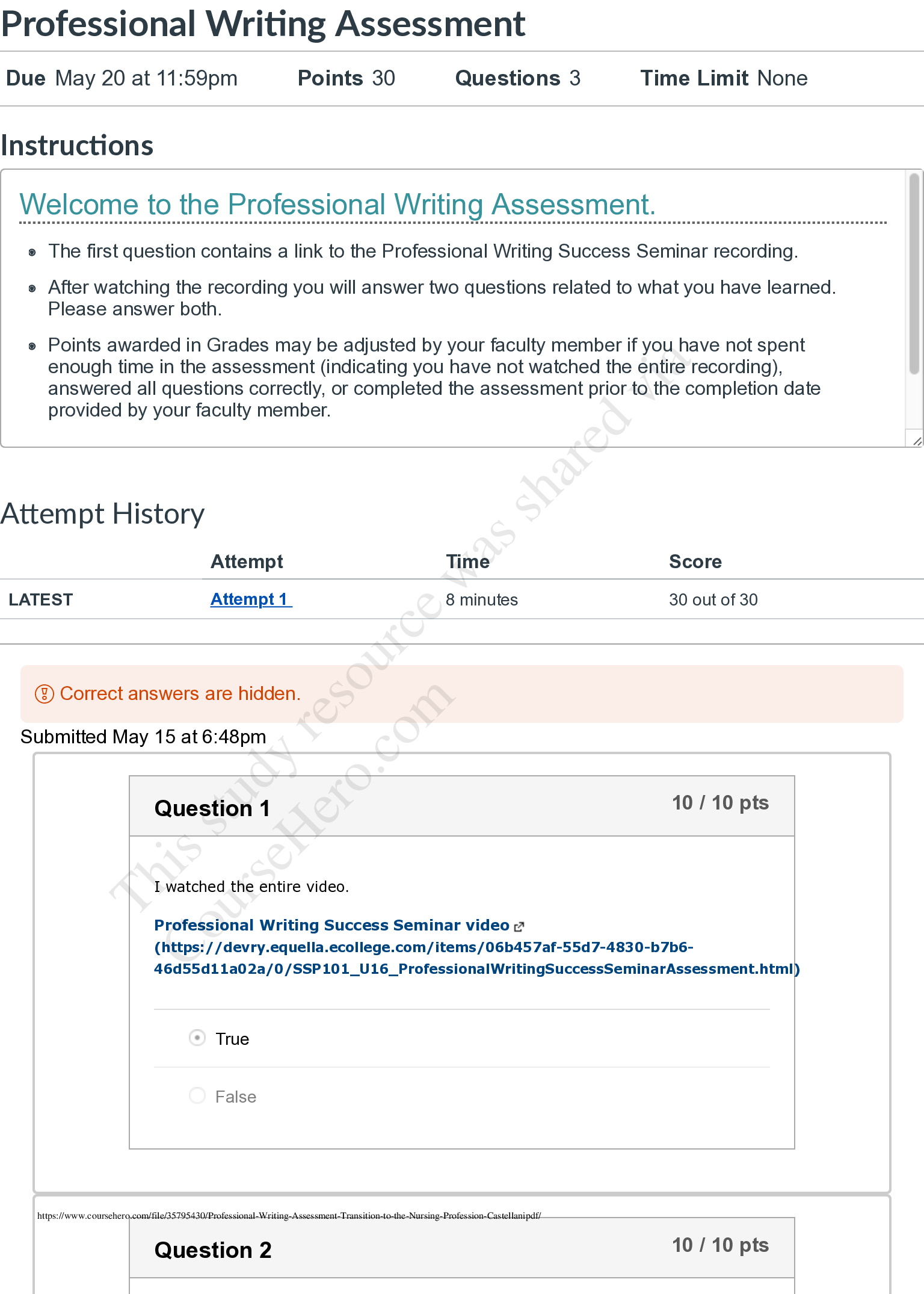

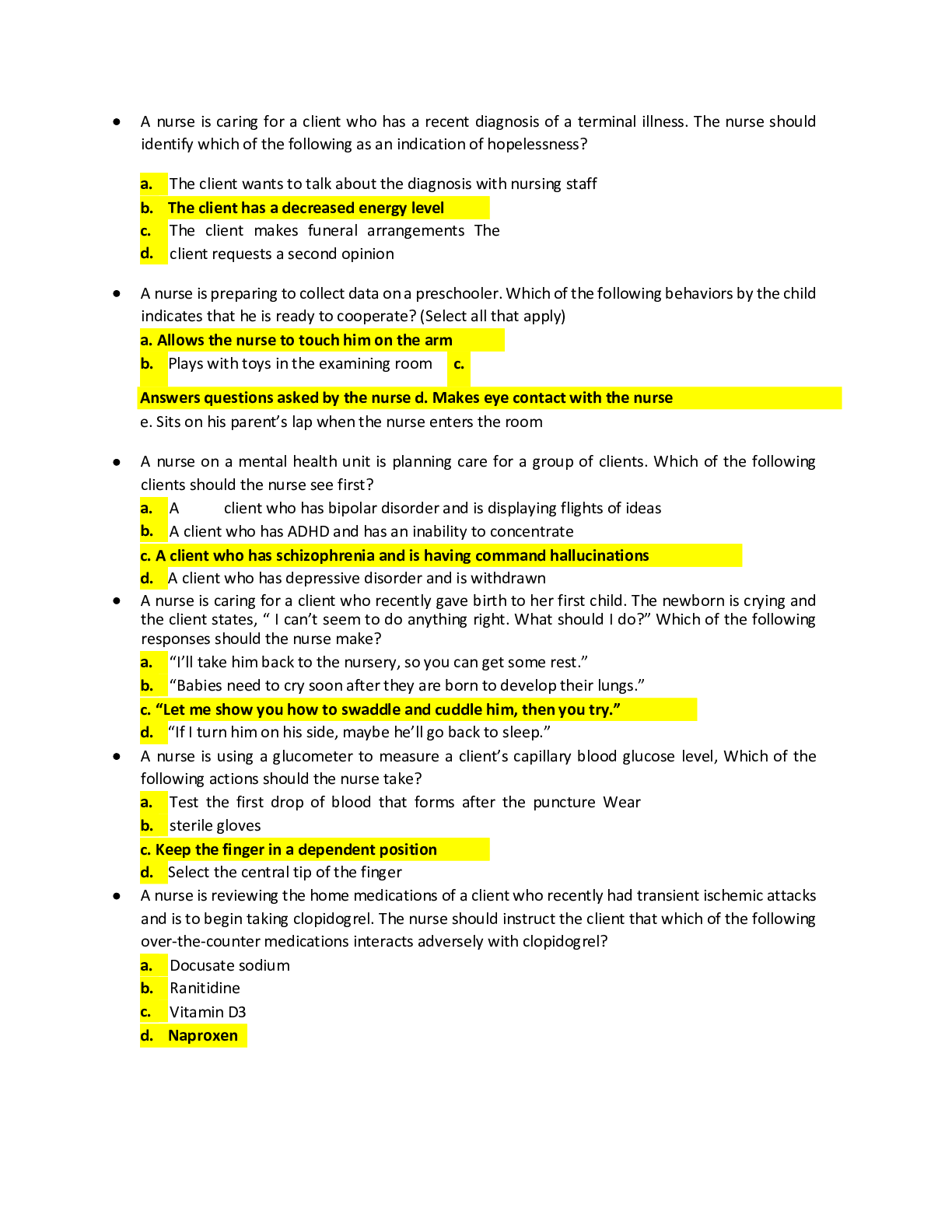
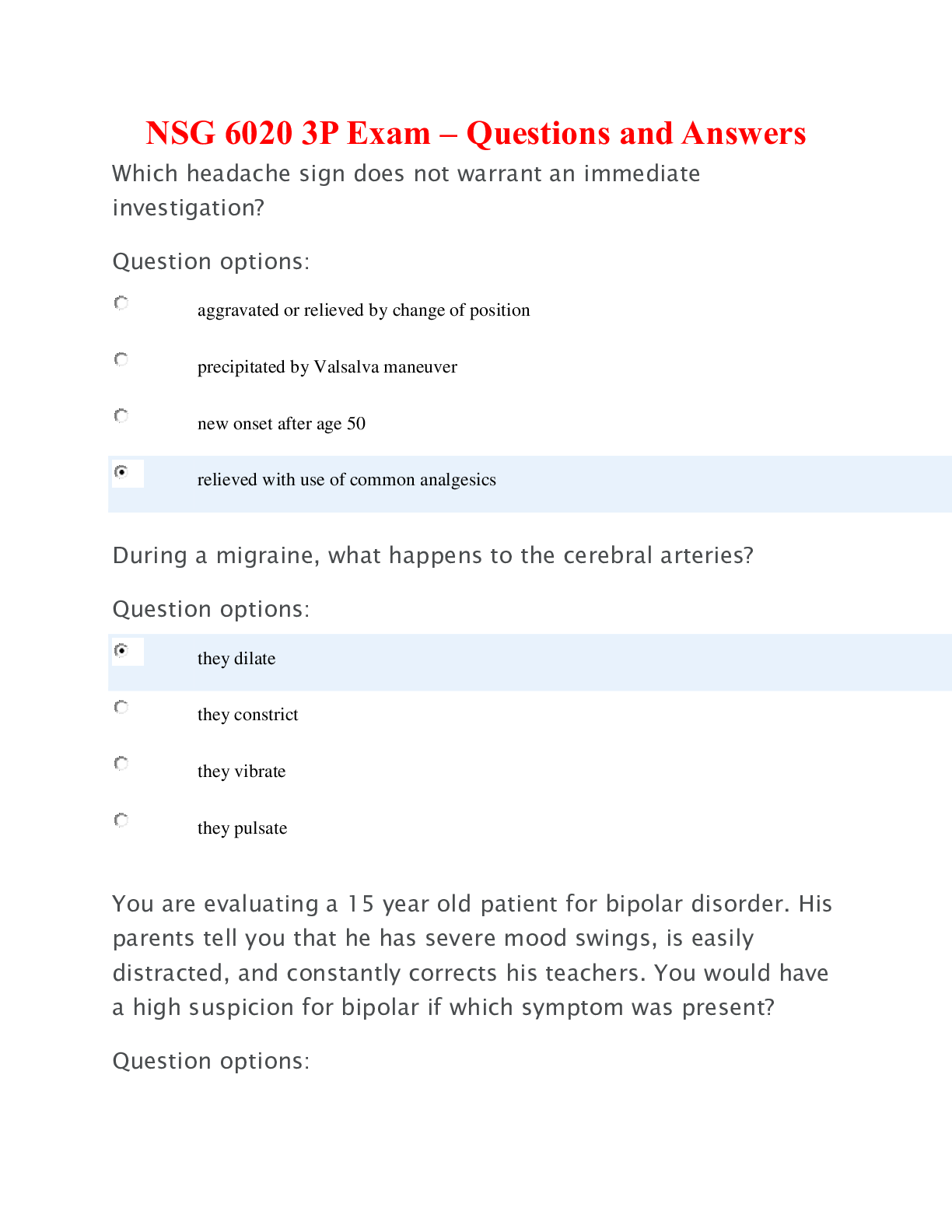
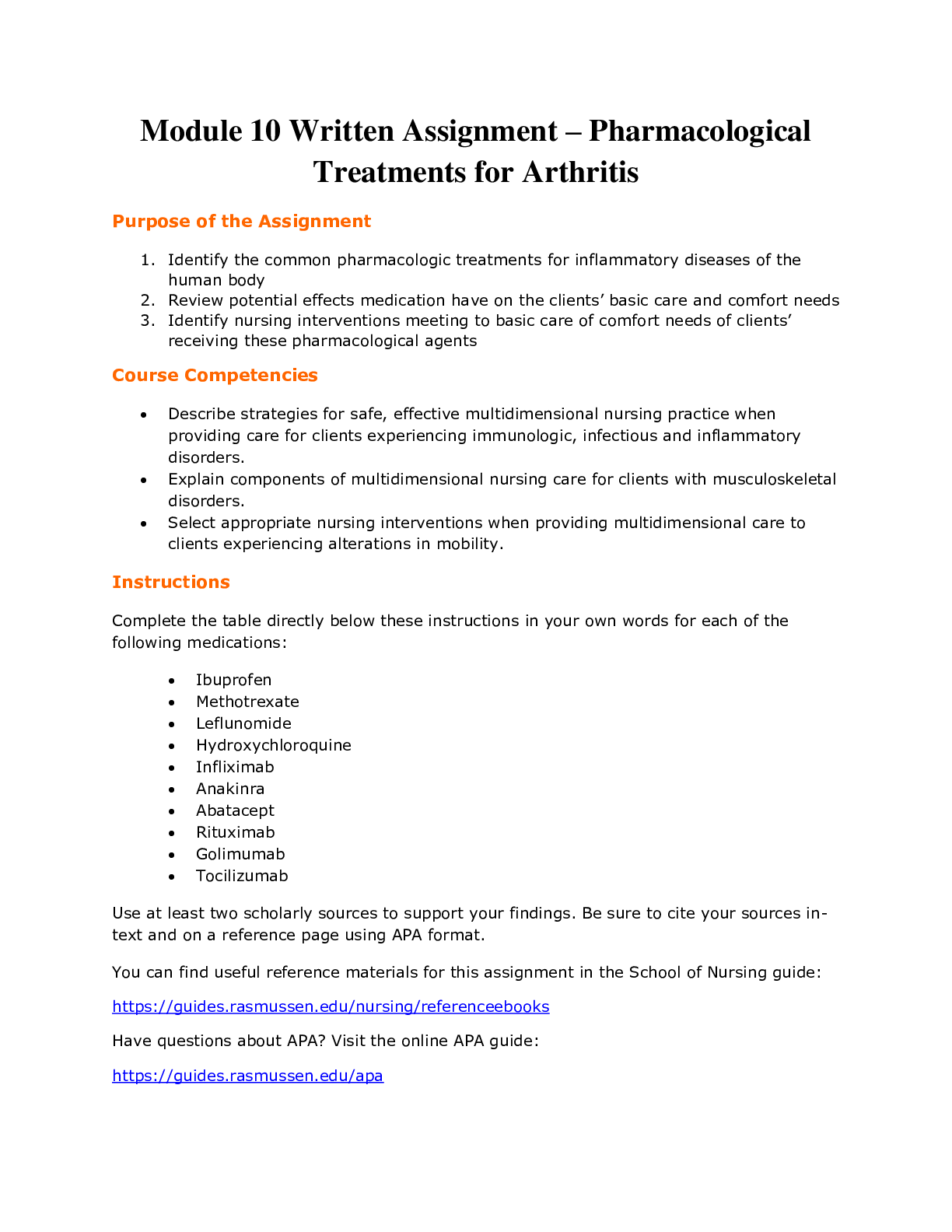

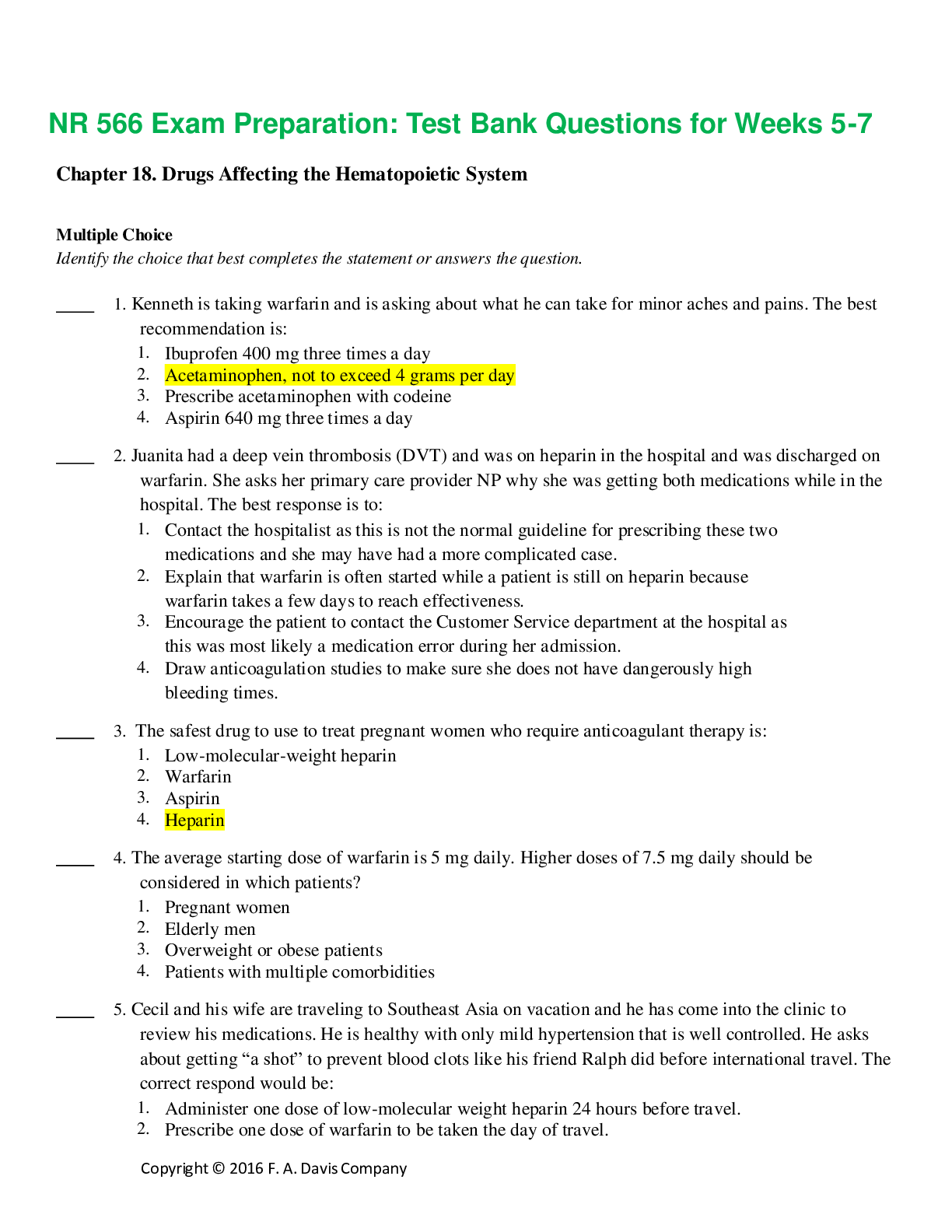

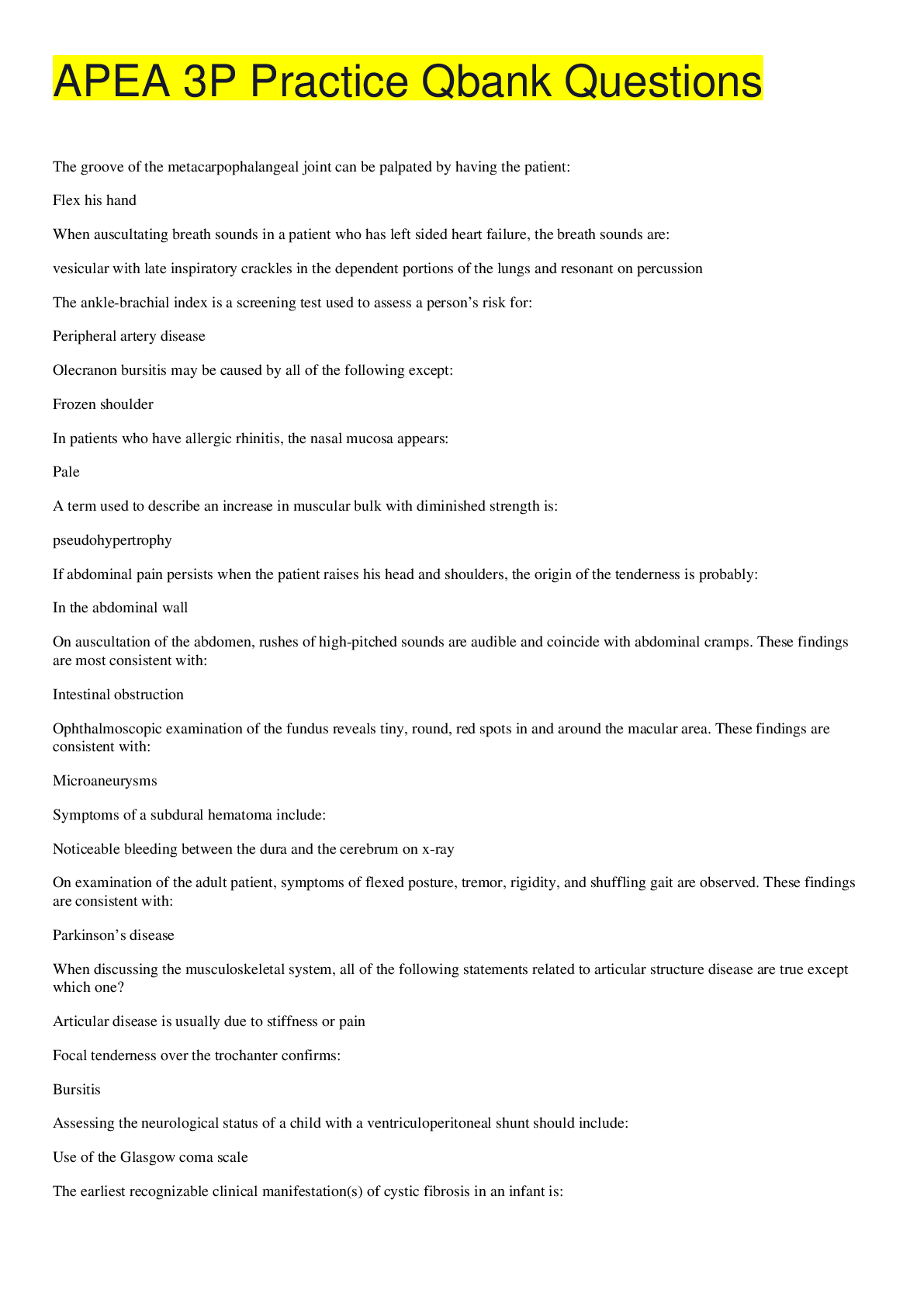
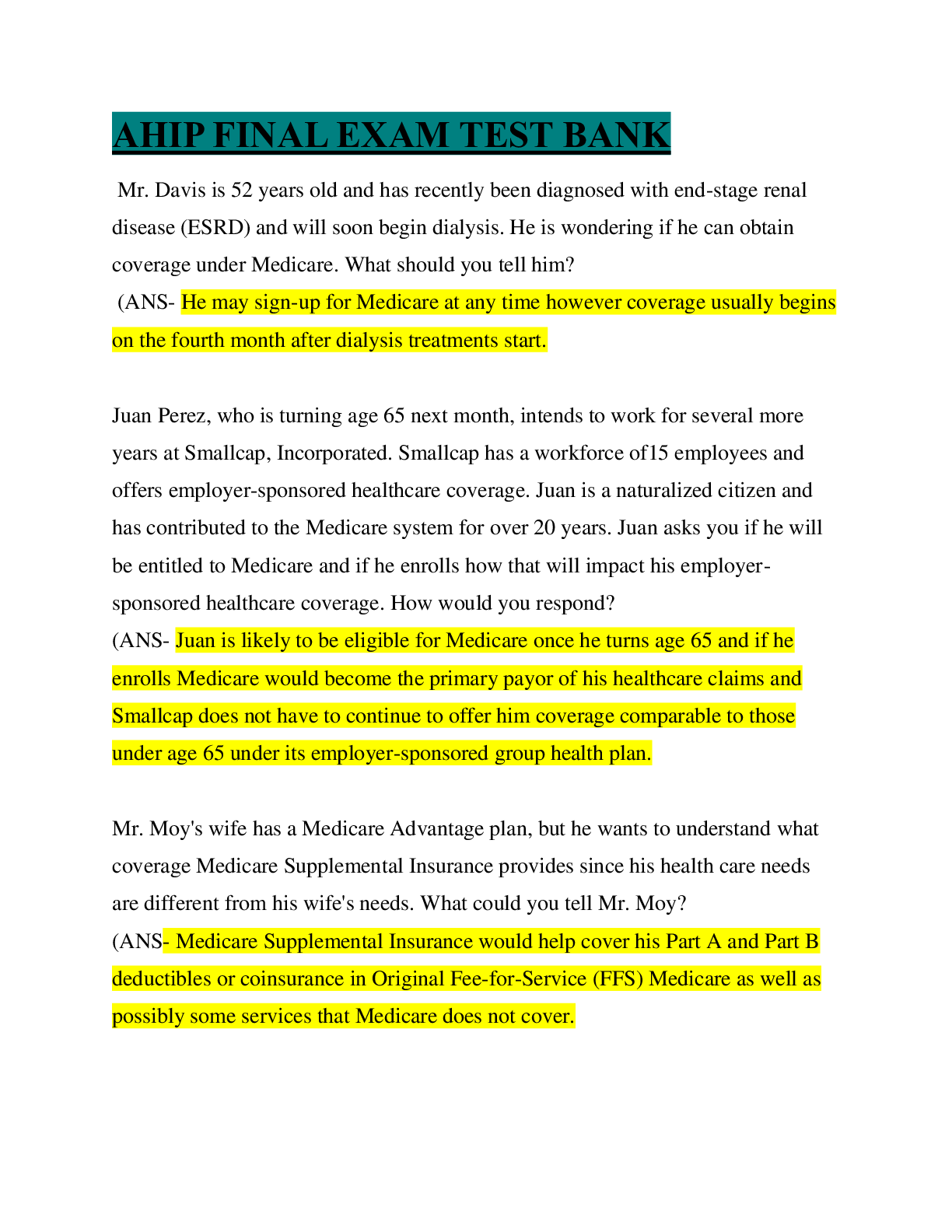
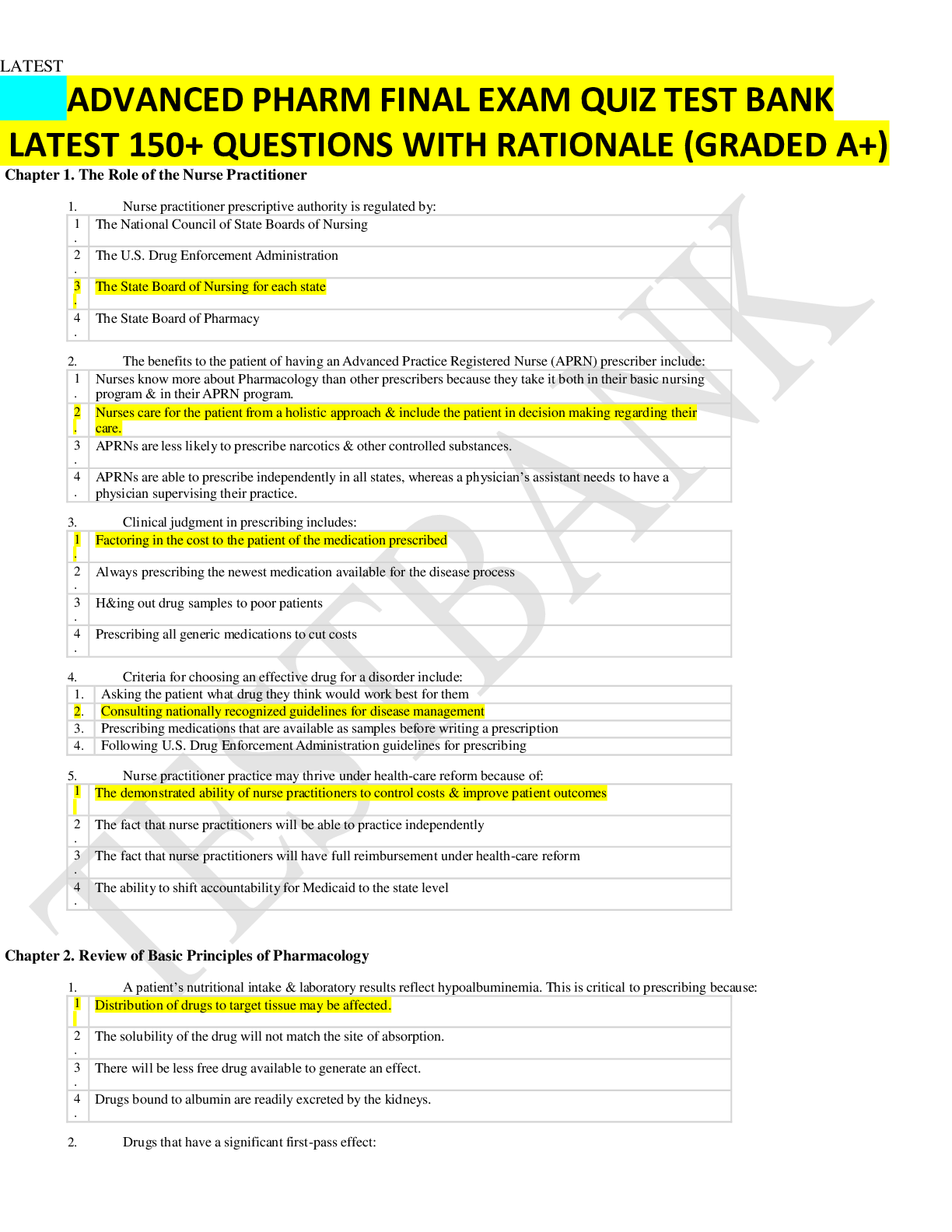


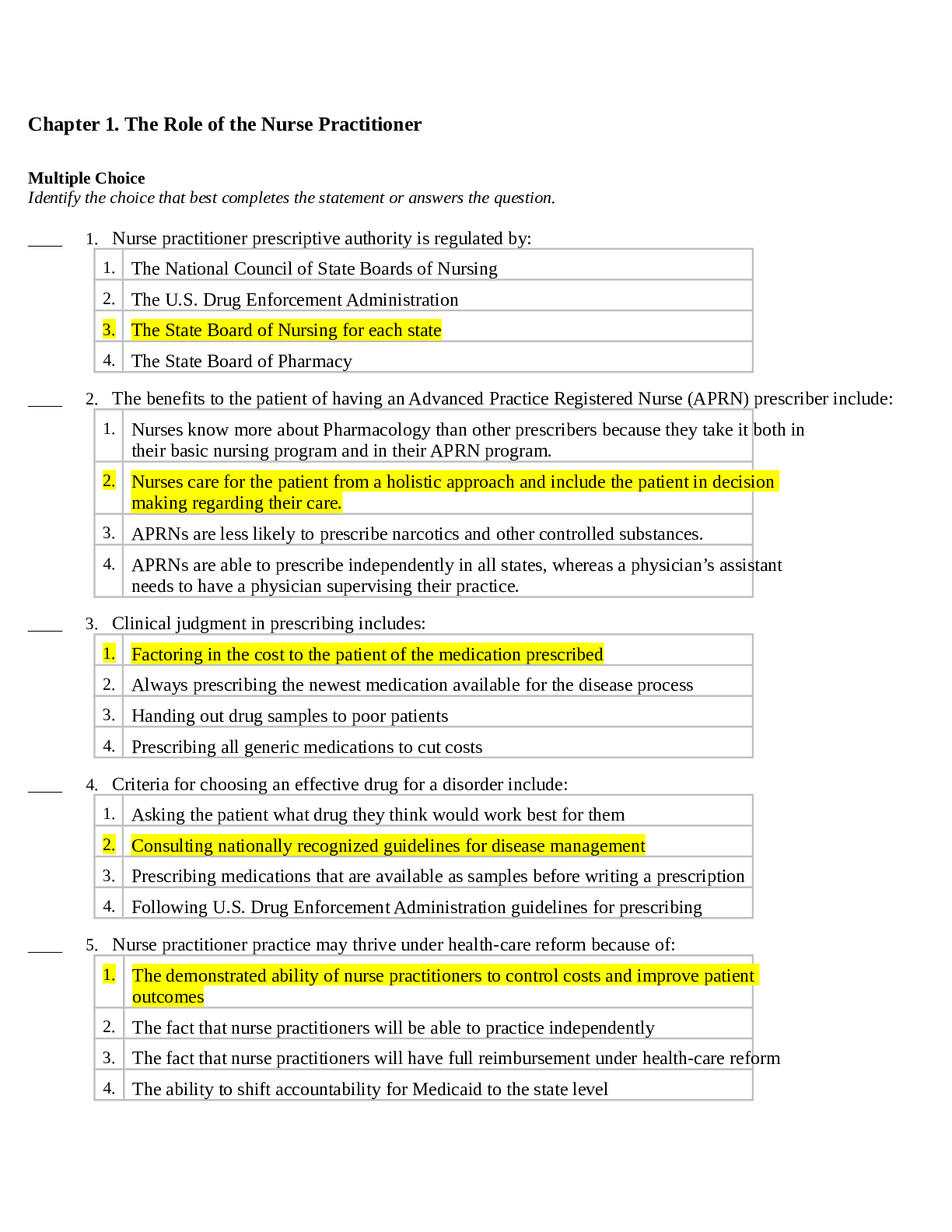
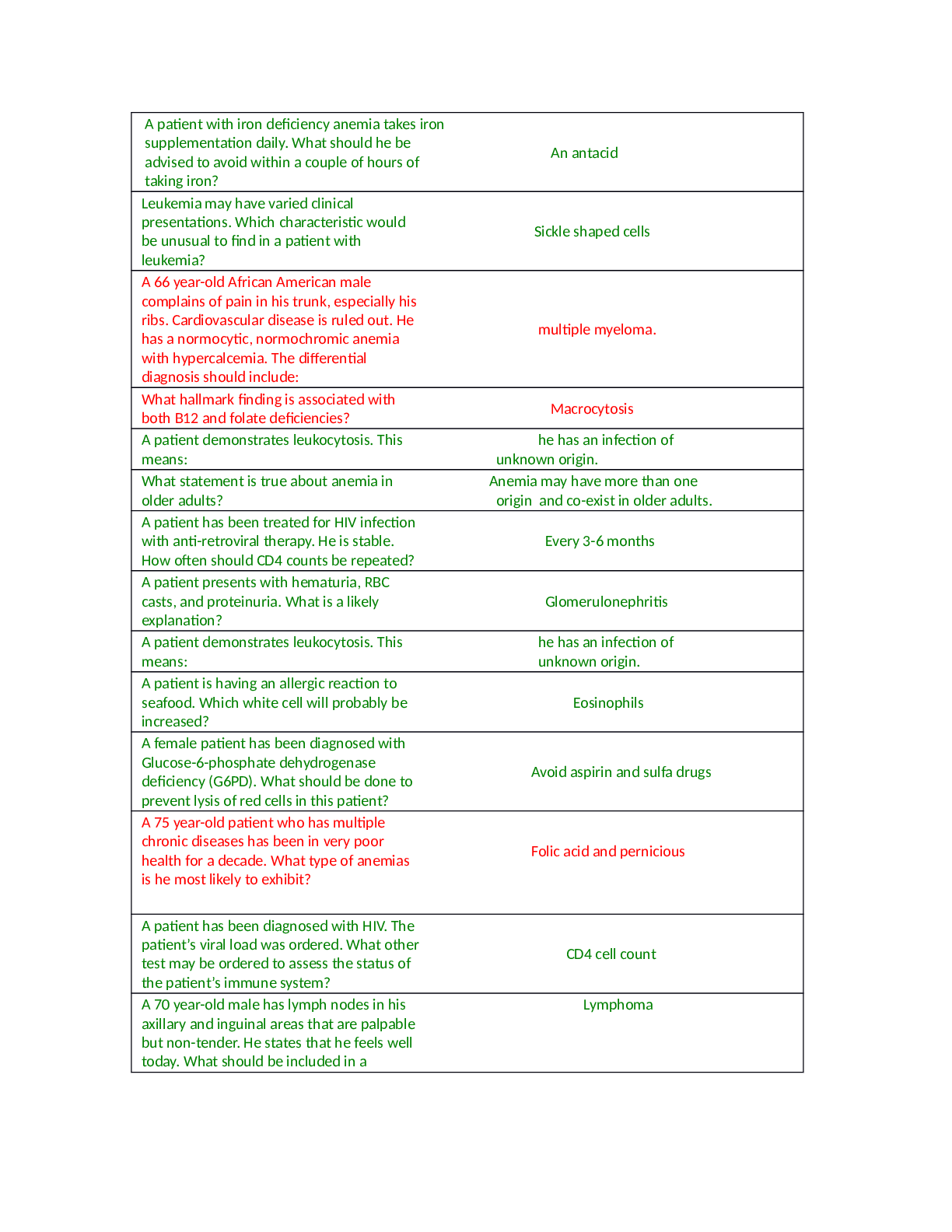
.png)
.png)
